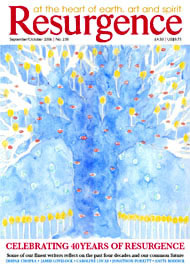THIS IS A wonderful book. It is beautifully written and rigorously researched. And it offers profound challenges both to academia – or certain versions of it – and to the wider modernist worldview in which academic projects are so often embedded.
The term ‘animism’ has traditionally been used to refer to a belief in spirits or an anthropocentric projection of consciousness onto the non-conscious world. In this ‘old’ use of the term, animists are often patronisingly constructed as people who cannot correctly distinguish between things and persons. This way of understanding animism is rooted in the Western world’s experience of nature and land as inanimate, and the projection of this as the right and mature way of seeing things.
Graham Harvey offers a vastly richer understanding. On this more recent usage of the term, “animists are people who recognise that the world is full of persons, only some of whom are human.” The key question from this perspective is how to live a life that engages appropriately with these persons – all of whom merit respect. The project of animism is thus a fundamentally ethical one. It is about learning how to live better as a human, in ways that support the flourishing of the whole community of persons to which humans belong.
The book itself takes a profoundly ethical position that is both inspirational and rare for a text written from within the academic paradigm. It challenges academia to resist the imperialistic imposition of its own worldview as a starting point for research, and to enter instead into real, engaged dialogue. This goes beyond a superficial respect for other cultures and differences to the kind of dialogue that can throw light on the typically unnoticed and unchallenged sets of assumptions, beliefs and values that make up our own worldviews. This is both challenging and liberatory, offering us a way of noticing, understanding and critiquing sets of assumptions that ordinarily encircle our thoughts and ways of living as invisible constraints.
Harvey understands his book as itself part of an ongoing dialogue rather than an attempt to summarise animist ways of relating to the world.
As part of this dialogue, case studies focusing on Ojibwe language, Maori arts, Aboriginal law and land and Eco-Paganist activism sketch and explore different animist ways of living and of experiencing the world. From the observation that, while some stones are persons in Ojibwe culture, not all stones are, to the discussion of Maori houses as bodies which we enter in a literal sense, these chapters are full of fascinating and sensitively delineated details that effectively dispel any lingering myth of animism as a single or simple worldview.
Harvey makes it clear that animism is chosen and practised – how to live well as an animist is something that needs to be learned. This is true for animists who live within animist societies as well as for those who do not. How, for example, do different animists identify persons? How do they deal with the complex ethical issues around identifying what, in a world full of persons, it is appropriate to eat, and when persons can legitimately be killed? The exploration of these questions is compelling, and suggests avenues for further research. A constructive dialogue could emerge, for example, from considering how animist worldviews might intersect with a particular ‘Western’ environmental position – that held by those who recognise inherent value across the other-than-human world, but find a special significance in the ability to suffer pain that helps solve the problem of what to eat.
A further aim of the book, and a further reason for lauding it as an ethical work, is to contribute, not just to knowledge of other ways of living, but to the actual project of developing “better ways to live as humans, even in academia”. Harvey implies, for example, a criticism of intensive agriculture as one of the many ways in which we de-personalise and commodify the living world, and enlists Val Plumwood, amongst others, in challenging the modernist worldview that underpins ways of living that are so often oppressive and destructive in relation to persons of all kinds. The final call is to accept the challenge of living better as humans by recognising and celebrating both similarity and difference – as opposed to recognising and denigrating difference, or attempting to assimilate it – and by undertaking the lifelong process of learning how to engage respectfully with persons of all kinds.
“We have never been separate, unique or alone and it is time to stop deluding ourselves. Human cultures are not surrounded by ‘nature’ or ‘resources’ but by ‘a world full of cacophonous agencies’, i.e. many other vociferous persons. We are at home and our relations are all around us. The liberatory ‘good life’ begins with the respectful acknowledgement of the presence of persons human and other-than-human, who make up the community of life. It continues with yet more respect and relating.”
Kate Rawles is a college lecturer and freelance outdoor philosopher.







